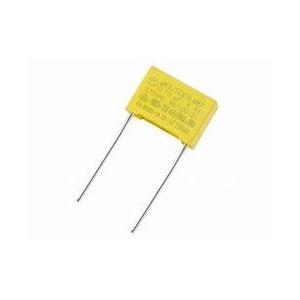Outer Coating Flame Retarding Epoxy Resin Film Capacitor Epoxy Resin
Add to Cart

Outer Coating Flame Retarding Epoxy Resin Film Capacitor Epoxy Resin
| OPERATION TEMPERATURE | -40℃~70℃,Tmax +85℃ |
| TOLERANCE | ±5%;±10% |
| COLOR | Yellow |
| ENCAPSULATION | Outer coating Flame retarding epoxy resin |
| CHARACTERISTICS | Wide capacitance range,small size and light weight |
| specification data | DATA SHEET |
| PACKAGE TYPE | Leads Tinned Wire |
| CAPACITANCE | 2.5uf |
| CERTIFICATION | VDE,SGS,CQC |
| PLACE OF ORIGIN | GUANGZHOU ,CHINA |
Detect with resistance gear
Practice has proved that the charging process of the capacitor can
also be observed by using a digital multimeter, which is actually a
discrete digital quantity to reflect the change of the charging
voltage. Assuming that the measurement rate of the digital
multimeter is n times per second, while observing the charging
process of the capacitor, n independent and sequentially increasing
readings can be seen every second. According to this display
feature of the digital multimeter, the quality of the capacitor can
be detected and the size of the capacitance can be estimated.
Introduced below is the method of detecting capacitors by using the
resistance gear of a digital multimeter, which is very useful for
instruments without capacitance gears. This method is suitable for
measuring large-capacity capacitors ranging from 0.1 μF to several
thousand microfarads.
Electric double layer capacitance
It is produced by the confrontation of charges at the
electrode/solution interface through the orientation of electrons
or ions. For an electrode/solution system, an electric double layer
is formed at the interface of the electronically conducting
electrode and the ionically conducting electrolyte solution. When
an electric field is applied to the two electrodes, the anions and
cations in the solution migrate to the positive and negative
electrodes respectively, forming an electric double layer on the
surface of the electrodes; after the electric field is removed, the
positive and negative charges on the electrodes are in phase with
the oppositely charged ions in the solution. The attraction makes
the electric double layer stable, and a relatively stable potential
difference is generated between the positive and negative
electrodes. At this time, for a certain electrode, an opposite ion
charge equivalent to the charge on the electrode will be generated
within a certain distance (dispersion layer) to keep it
electrically neutral; when the two electrodes are connected to the
external circuit, the The charge migrates to generate a current in
the external circuit, and the ions in the solution migrate into the
solution to be electrically neutral, which is the charging and
discharging principle of the electric double layer capacitor.
filter
Theoretically (that is, assuming that the capacitor is a pure capacitor), the larger the capacitor, the smaller the impedance and the higher the passing frequency. But in fact, most of the capacitors exceeding 1μF are electrolytic capacitors, which have a large inductance component, so the impedance will increase when the frequency is high. Sometimes you will see an electrolytic capacitor with a large capacitance connected in parallel with a small capacitor. At this time, the large capacitor filters low frequencies, and the small capacitor filters high frequencies. The function of the capacitor is to pass the alternating current and block the direct current, and pass the high frequency and block the low frequency. The larger the capacitance, the easier it is for high frequencies to pass. Specifically used in filtering, the large capacitor (1000μF) filters the low frequency, and the small capacitor (20pF) filters the high frequency. Some netizens have vividly compared the filter capacitor to a "pond". Since the voltage across the capacitor will not change abruptly, it can be seen that the higher the signal frequency, the greater the attenuation. It can be vividly said that the capacitor is like a pond, and the water volume will not change due to the addition or evaporation of a few drops of water. It converts changes in voltage into changes in current, and the higher the frequency, the greater the peak current, which buffers the voltage. Filtering is the process of charging and discharging.

